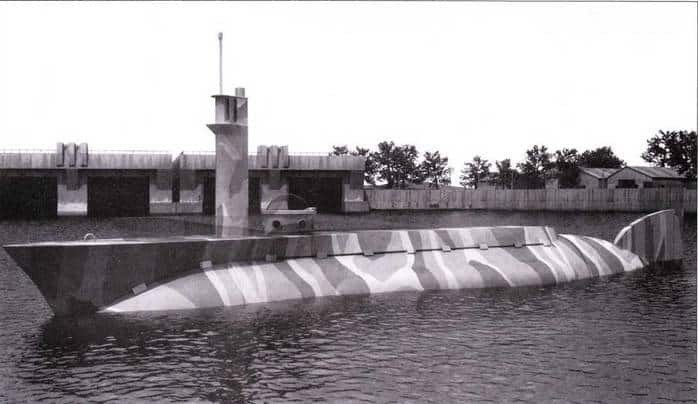
The prototype of this boat had been under construction
since March 1944.
Seeteufel was an attempt to overcome the difficulties
inherent in launching and recovering human torpedoes and small submarines. A
submarine equipped with tracks, the arrangement provided for autonomous
unloading and water entry and exit. It also expanded the number of possible
launching and recovery areas and potentially allowed a shorter water transit
time to the operational area.
Designed and built in four months, the prototype had a crew
of two, displaced 35 tons and was 14.2m long. An 80hp gasoline engine could
drive the tracks or propeller, giving the vessel a speed of 10km/h on land and
10kt on the surface. Submerged, it could cruise at 8kt using a 25hp electric
motor.
Unlike the manned torpedoes and other midget submarines,
which were armed with a variant of the G7e torpedo with fewer batteries and a
reduced range and speed, the Seeteufel possessed a flooding device that enabled
it to employ the standard G7e. Alternatively, it could carry four mines. It was
also equipped with either a machine-gun or flamethrower for use on land.
While performance in the water was satisfactory, on land it
was underpowered and had an excessive ground pressure due to the narrow tracks.
Additional prototypes with a more powerful engine and wider tracks were planned
as a prelude to series production. However, the Oberkommando der Marine (OKM)
canceled the project in 1944 as part of a plan to rationalize midget submarine
development.
Vizeadmiral (Vice Admiral) Hellmuth Heye, commander of the
German Naval Special Forces (German: Kleinkampverbände, lit. ‘Small Combat
Units’), stated in 1944:
“I consider
the Sea Devil a promising weapon for use in commando raids. It is independent
of mother craft and base personnel, can land on foreign shores, commit acts of
sabotage, and evade pursuit ashore or afloat. It can be taken to site by a
mother ship equipped with a large crane. With an engine of higher output than
that of the experimental boat, a speed of 8 to 10 knots can be obtained. Speed
and radius of action could be further increased by installation of a
closed-cycle engine. Intended for use in coastal waters if weather is not too
rough, and on rivers, lakes and artificial lakes…
Description: Midget
U-boat
First launched: 1944
Complement, Off / Men 2
Displacement surf: circa
2,0 t
Displacement subm: 18,0
– 20,0 t
Length: 13,5 m
Beam, max: circa
2,0 m
Depth: 2,9 m
5,5 m (with schnorkel mast)
Max speed surfaced: ?
Max speed submerged: 10
kt (petrol/gas – with Schnorkel)
8 kt (Electric)
Radius surfaced: 30
hours at top speed
80 hours at cruising speed
Radius submerged: 30
hours at top speed (petrol/gas)
10 hours at top speed (electric)
80 hours at cruising speed (petr/gas)
20 hours at cruising speed (electric)
Max diving depth: 50
m (prototype made 20 m)
Nr of torpedoes / mines: 2 or 4